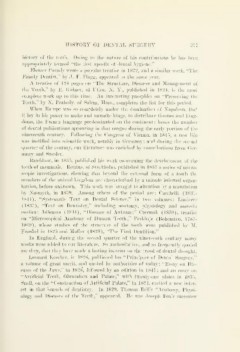Page 417 - My FlipBook
P. 417
HISTOEY or DENTAL SURGEEY 377
iiistory of the teetli. Owing to the nature of liis contributions he has been
appropriately tennei] "the first apostle of dental hygiene."
Eleazer Parnily wrote a popular treatise in 1832, and a similar work, "The
Family Dentist/' by J. F. Flagg, appeared in the same year.
A treatise of 124 pages on "The Structure, Diseases and Management of
the Teeth," by E. (iidney, of I'tica, N. Y., puldished in 1831, is tlie most
complete work up to this time. An interesting pamphlet on "Preserving the
Teeth," by N. Pealwdy, of Salem, Mass., completes the list for this period.
When Euroi)e was so completely under the domination of Xapoleon, that
it lay in his jwwer to make and unnud'Ce kings, to distribute thrones and king-
doms, the French language predominated on the continent : hence the nundjer
of dental publications appearing in that tongue during the early portion of tlic
nineteenth century. Following tlie Congress of Vienna, in 1815, a new life
was instilled into scientific work, notably in Germany; and during the second
qiiarter of the century, our literature was enriched by contributions from Ger-
many and Sweden.
li'aschkow, in 1835, puldishcd his work concerning the development of the
teeth of nuimmals. Ketzius, of Stockholm, published in 1837 a series of micro-
scopic investigations, showing that licyond the external form of a tooth the
members of the animal kingdom are characterized by a minute internal organ-
ization, before unknown. This work was brought to attention by a translation
l)y Nasmyth, in 1839. Among others of the period are: Carabelli (1831-
1844), "Systematic Text on Dental Science," in two volumes; Linderer
(1837), "Text on Dentistry," including anatomy, physiology and materia
medica; Adleman (1844), "Diseases of Antrum;" Czermak (1850), treatise
on "Microscopical Anatomy of Human Teeth;" Perkinje (Bohemian, 1787-
1869), whose studies of the structure of the teeth were published by M.
Frankel in 1825 and Muller (1828), "The First Dentition."
In England, during the second cjuarter of the nineteenth century many
works were added to our literature. So authoritative, and so frequently quoted
ai-e they, that they have made a lasting imprint on the trend of dental thought.
Leonard Koecker, in 1826, published his "Principles of Dental Surgery,"
a volume of great merit, and quoted by authorities of today : "Essay on Dis-
eases of the Jaws," in 1838, followed by an edition in 1847: and an essay on
"Artificial Teeth, Obturators and Palate," with twenty-one plates in 1835.
Snell, on the "Construction of xYrtificial Palate," in 1834, excited a new inter-
est in that l)ranch of dentistry. In 1839, Thomas Bell's "Anatomy, Physi-
ology and Diseases of the Teeth," appeared. He was Joseph Fox's successor


